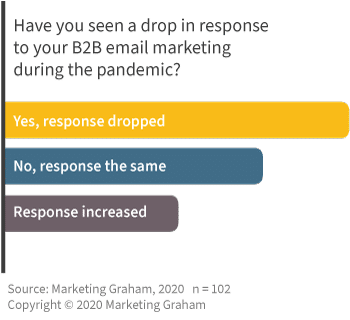Coronavirus has changed a lot of things – including marketing. In addition to making decision-makers more risk-averse, a lot of them are working from home. B2B lead generation needs to adapt.
Here are 5 things (there are more) that I’ve discovered during the coronavirus pandemic and changes I’ve made to my lead generation.
1. Email vs LinkedIn InMail
I’ve noticed a decline in real opens & clicks on email campaigns during the pandemic. I wanted to see if other B2B marketing experts have experienced the same drop. I did some research and you can see the result in the chart. It appears I’m not alone.
Two possible reasons:
a) It seems furlough (not allowed to access work emails) and redundancies (emails no longer delivered to the named person) have affected response – or maybe spam filters are getting better.
b) The reason I say ‘real’ opens & clicks is that I’m noticing an increasing amount of false-positives. Firms are using security bots to open and check email links before they are delivered. You think a person has clicked your beautifully crafted email, but it’s actually a security bot.
By contrast, LinkedIn InMails have no such problem. Every open and click is a real person. And the open/click rates are high. Averages are 57.5% open rate* and 3.6% click rate* (but I’ve had highly targeted campaigns achieve 72% open rate and 24% click).
And LinkedIn profiles are personal, not company property. So execs can access their LinkedIn page during furlough or redundancy to seek new opportunities.
Response to LinkedIn InMails is strong. Warning; it’s expensive. But would you rather pay £50 on an email campaign and get 1 response, or £1,000 on an InMail and get 10 responses? Yes, the cost per response is higher, but at least you can feed your hungry sales team.
My advice: Test LinkedIn InMail, but get them off the platform as soon as possible and on a video call or their mobile. Human interaction is still the best way to be persuasive and to handle objections.
2. Shake your existing clients
If you are struggling to get new clients, then squeeze as much value as you can from existing customers. Have you considered…
i) Developing new products/services (cross-sell);
ii) Adding extra features to existing products/services (upsell);
iii) Asking clients for introductions to new business;
iv) Cementing relationships so you don’t lose business to competitors; and
v) Account Based Marketing (ABM) is about focussing on key, high-profit accounts that are worth extra attention. Connect beyond the person that signed the contract, because there may be other buyers in your client’s organisation.
You’ve heard the saying “Acquiring a new customer can cost five times more than retaining an existing customer”. It was true pre-coronavirus, and it’s true now.
My advice: In the hunt for new business, don’t ignore existing clients. They know you and are more likely to take your call or respond to your email. An easier sell.
3. Accept that buyers are now more risk-averse
Numerous pieces of research have indicated the average buying team has grown by over 25% from 5 to almost 7 people in two years**. The conclusion has been that the primary buyer is spreading the risk (“It wasn’t my decision, it was a team decision”).
That fear of risk has been heightened during the pandemic. Nobody wants to spend their limited budget on a white elephant and potentially be on the list for redundancy.
But there are many things you can do to de-risk the purchasing decision.
If you de-risk your solution, and your competitors don’t, you stand a better chance of getting the order.
My advice: Check out my blog article, which includes a table of de-risking solutions; ‘Your B2B brand: Nobody buys from a clown’. You might also like to read ‘Purchases for yourself are different from purchases for your company’
4. Search Engine Optimisation (SEO) is now vital
During the pandemic, buyers have become more cautious. More likely to engage only when they have an urgent need/want/pain (and the budget to solve it). Pre-coronavirus you could engage before they decided to buy, that’s now becoming a struggle.
But when they start to build their shopping list of potential suppliers, one of the resources they use are search engines (OK, let’s not kid ourselves, it’s Google 90% of the time). This is true whether they are working in the office or at home.
Remember, on average, 60% of traffic to a website comes from search engines***.
The problem is the whole world and its mother has woken up to the fact – so getting a good organic ranking on search engines has become more difficult.
The temptation is to try and cheat your way to a good ranking, and many agencies will tell you they can do it. Don’t be tempted. Google is very smart, it’s algorithms know the tricks people use and will penalise organisations that use them.
My advice: Follow Google’s rules (see ‘How to get a higher ranking on Google’), create great content (see ‘A practical guide to content marketing’) and structure your website to rank/perform well (I’m working on an article titled ‘The ingredients for a successful B2B website’).
5. Stay ‘front of mind’ until buyers are ready to buy
Most people that visit your website are a ‘not now’. They may not be ready to buy now, but that could change when the economy improves.
Most of your visitors will be at the prospect stage (see diagram below). They are investigating options and asking “What can satisfy my need?” – it’s too early for them to be asking “Who can satisfy my need?”
Develop a nurturing programme that maintains your brand’s visibility (without the hard sell). Google Remarketing has been quite successful in this process. It targets people who have previously visited your website with display advertisements.
The adverts are shown on the Google Display Network, which consists of 2m websites and includes big names such as eBay, the Daily Mirror website and even the Argos online store.
So as your visitors are travelling around the world wide web, they bump into your adverts on other websites – a gentle reminder of your proposition, benefits and (hopefully) useful content.
The key metric here is not just the number of clicks on the remarketing adverts (average is 0.07% according to MailChimp, but I’m getting an average of 2-3%), it’s more about the number of impressions you can afford (impression = the number of times your advert is shown). More impressions mean more visibility.
My advice: Test Google Remarketing (you will need a minimum of 100 active website visitors within the last 30 days) and take Google’s advice on fine-tuning your adverts. Don’t judge success merely by the click rate.
What next?
Be bold. Many of the changes that have occurred as a result of coronavirus will last a long time (more people working from home?), so rethink your short-term and long-term plans.
Lead generation during coronavirus can be difficult, very difficult, but not impossible. If you need some advice, book a 1-hour free B2B marketing consultation and I’ll do my best to help. Click the button below.
* Source: LinkedIn Sponsored InMail Overview
** Source: Harvard Business Review
*** Source: Growth Badger


